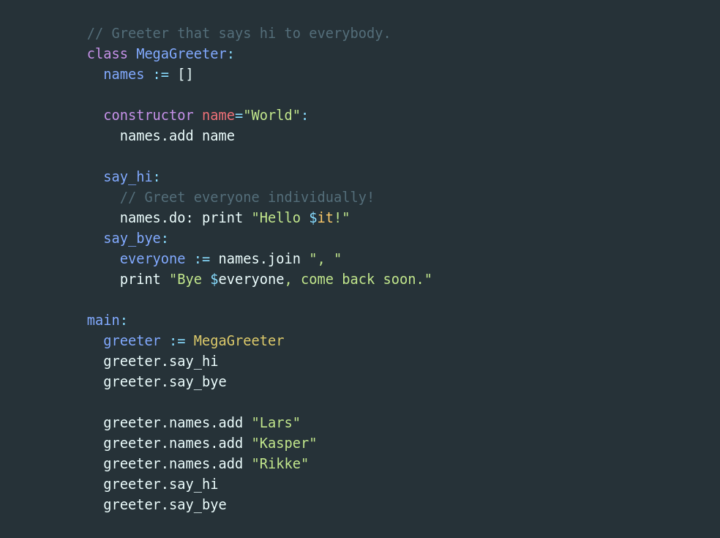Developed by a team of former Google employees, Toit is a complete IoT platform with remote management, firmware updates for fleets of devices with features similar to the one offered by solutions such as balena, Microsoft Azure, or Particle edge-to-cloud platform.
Toit currently works on ESP32 microcontrollers using lightweight containers, and after seeing existing high-level languages MicroPython and Javascript were not fast enough on low-end microcontrollers platforms, the team at Toit started to develop the Toit language in 2018, and has just made it open-source with the release of the compiler, virtual machine, and standard libraries on Github under an LGPL-2.1 license.
One of the main reasons to switch from MicroPython to the Toit language is if your application is limited by performance or you operate ESP32 from a battery, as Toit claims up to 30x faster performance with Toit on ESP32:
We went into crunch mode and some months later, we had the first results. We were executing code more than 30x faster than MicroPython on an ESP32 with a high-level language that abstracts away memory allocation and that can be learned in a few hours by a Python developer: the Toit language.
So let’s have a deeper look by trying it out in Ubuntu 20.04. The virtual machine is based on a fork of the ESP-IDF with custom malloc implementation, allocation fixes for UART, and LWIP fixes. That’s what we’ll need to install first:
|
1 2 3 4 5 6 |
git clone https://github.com/toitware/esp-idf.git pushd esp-idf/ git checkout patch-head-4.3-3 git submodule update --init --recursive export IDF_PATH=$(pwd) popd |
Now install ESP32 tools:
|
1 2 3 |
sudo apt install python3-pip $IDF_PATH/install.sh . $IDF_PATH/export.sh |
and build toit and samples to run on the host machine:
|
1 2 3 |
sudo apt install go --install=classic sudo apt-get install gcc-multilib g++-multilib make tools |
We can now run the hello world sample:
|
1 2 3 4 5 6 |
// Copyright (C) 2021 Toitware ApS. // Use of this source code is governed by a Zero-Clause BSD license that can // be found in the examples/LICENSE file. main: print "Hello, World!" |
as follows:
|
1 2 |
build/host/bin/toitvm examples/hello.toit Hello, World! |
That’s all good but what’s about building the sample for ESP32? Easy:
|
1 |
make esp32 |
This will create a Toit firmware file (toit.bin) preloaded with the hello world sample and that can be flashed with esptool:
|
1 2 3 4 5 6 |
LD build/esp32/toit.elf esptool.py v3.1-dev Merged 2 ELF sections To flash all build output, run 'make flash' or: python /home/jaufranc/edev/esp-idf/components/esptool_py/esptool/esptool.py --chip esp32 --port /dev/ttyUSB0 --baud 921600 --before default_reset --after hard_reset write_flash -z --flash_mode dio --flash_freq 40m --flash_size detect 0xd000 /home/jaufranc/edev/toit/build/esp32/ota_data_initial.bin 0x1000 /home/jaufranc/edev/toit/build/esp32/bootloader/bootloader.bin 0x10000 /home/jaufranc/edev/toit/build/esp32/toit.bin 0x8000 /home/jaufranc/edev/toit/build/esp32/partitions.bin make[1]: Leaving directory '/home/jaufranc/edev/toit/toolchains/esp32' |
Good, but surely we can check a sample with Wi-Fi, and indeed there’s the http.toit sample:
|
1 2 3 4 5 6 7 8 9 10 11 12 13 14 15 16 17 18 19 20 21 22 |
// Copyright (C) 2021 Toitware ApS. // Use of this source code is governed by a Zero-Clause BSD license that can // be found in the examples/LICENSE file. import net import http main: network := net.open host := "www.google.com" socket := network.tcp_connect host 80 connection := http.Connection socket host request := connection.new_request "GET" "/" response := request.send bytes := 0 while data := response.read: bytes += data.size print "Read $bytes bytes from http://$host/" |
That neat and simple example simple download Google page and reports the number of bytes downloaded. But wait… Where do we configure Wi-Fi credentials? This can be done at build time:
|
1 |
make esp32 ESP32_ENTRY=examples/http.toit ESP32_WIFI_SSID=myssid ESP32_WIFI_PASSWORD=mypassword |
or you can change the default program and configure the WiFi SSID and password in the Makefile:
|
1 2 3 4 5 |
# Use 'make ESP32_ENTRY=examples/mandelbrot.toit' to compile a different # example for the ESP32 firmware. ESP32_ENTRY=examples/hello.toit ESP32_WIFI_PASSWORD= ESP32_WIFI_SSID= |
I do not have an ESP32 up and running to test it out, but I’d assume you’d be able to modify the hello.toit on the device itself after flashing Toit firmware the first time. OTA firmware update should be enabled too based on the output from the make esp32 command. The complete Toit platform is free to use for up to 10 devices, and besides the Github page, you can also find additional information on the documentation website not only about the firmware and Toit language we’ve used here, but also the Cloud API and Toit platform as a whole.

Jean-Luc started CNX Software in 2010 as a part-time endeavor, before quitting his job as a software engineering manager, and starting to write daily news, and reviews full time later in 2011.
Support CNX Software! Donate via cryptocurrencies, become a Patron on Patreon, or purchase goods on Amazon or Aliexpress





